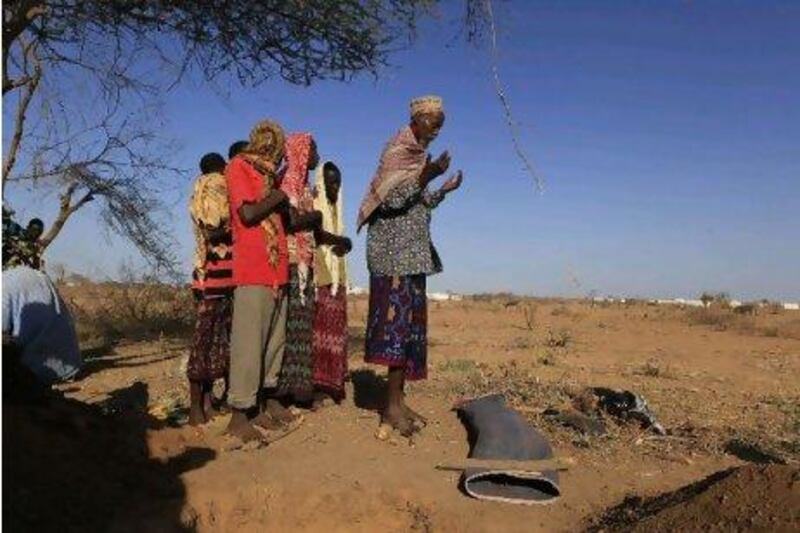DADAAB, Kenya // Faduma Sakow Abdullahi and her five children tried to escape starvation in Somalia by travelling to a Kenyan refugee camp.
Only one day before they reached their destination, her four-year-old daughter and five-year-old son died from a combination of exhaustion and hunger.
At first, the 29-year-old widow thought the two were merely sleeping when they would not wake up after a brief rest.
She had to leave their bodies under a tree, unburied, so she could push on with her two-year-old and three-year-old.
She saw more than 20 other children dead or unconscious and abandoned on the roadside. Eventually a passing car rescued the rest of her family.
"I never thought I would live to see this horror," she said, as she described the 37-day trek to Dadaab, the world's largest refugee camp.
Tens of thousands of Somalis have watched their land dry up after years without rain.
Now they have to make the perilous journey over parched earth to refugee camps in Kenya and Ethiopia, regions that also have been hit hard by drought.
The United Nations expects at least 10 million people will need food aid.
A US aid official said on Monday that he believed the situation in Ethiopia was even worse than the government there has so far acknowledged.
The Ethiopian government announced on Monday that 4.5 million people need food aid there, 40 per cent more than last year. Jason Frasier, mission director of USAID in Ethiopia, the US government aid arm, suggested that Ethiopia might not be aware of the true scale of the disaster.
Aid agencies have appealed for more than US$100 million (Dh367m) in emergency funding, while warning of dire consequences if help does not arrive.
Dadaab was originally built for 90,000 people but it now accomodates 382,000.
The head of UN's refugee agency, Antonio Guterres, said on Sunday while visiting the new arrivals area: "I must say that I visited many refugee camps in the world. I have never seen people coming in such a desperate situation."
Most of those who have come to Dadaab are former subsistence farmers whose lands were rendered idle and whose animals were wiped out after successive seasons of drought hit their war-ravaged country.
Hundreds of mothers and children with dust-caked faces gather at 6am every day at registration centres in Dadaab's three sprawling camps.
Mrs Abdullahi, who lost two of her children during her journey, said her family's problems took a turn for the worse after her husband died in May.
Still, with 20 cows and a small parcel of land, her family had enough to live on.
But when the rains failed, the cows died and their supply of maize ran out.
"We started to dig up roots of trees to survive," Mrs Abdullahi said.
While Mrs Abdullahi had made it to the camp, in many cases parents, have died first.
Andrew Wander, a spokesman for Save the Children, said his agency provides care to more than 300 unaccompanied children who were found on roadsides after their parents had died or abandoned them. "More children have died of malnutrition in the first four months of this year than in the whole of last year," he said.
Abdi Aden, a former farmer who lived in Sakow town before the drought forced him to flee, said his eight-year-old son died after eight days of trekking.
"He tried to cry before he died, but he could not. He was so weak. He died peacefully from hunger," he said.
"I buried him by myself in a shallow ditch so hyenas could not eat him."





